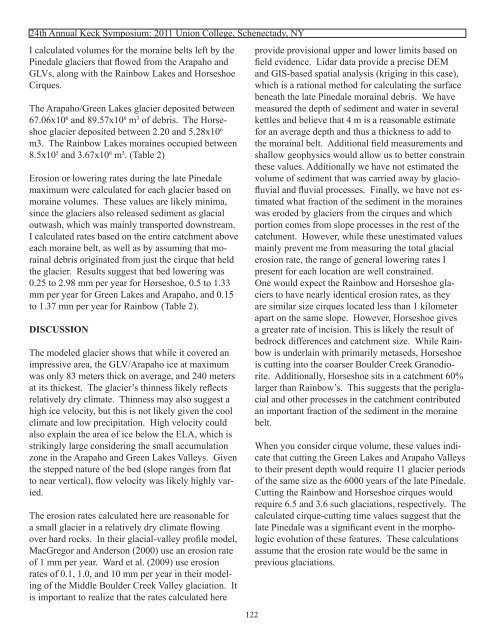keck geology consortium proceedings of the twenty-fourth annual ...
keck geology consortium proceedings of the twenty-fourth annual ...
keck geology consortium proceedings of the twenty-fourth annual ...
You also want an ePaper? Increase the reach of your titles
YUMPU automatically turns print PDFs into web optimized ePapers that Google loves.
24th Annual Keck Symposium: 2011 Union College, Schenectady, NY<br />
I calculated volumes for <strong>the</strong> moraine belts left by <strong>the</strong><br />
Pinedale glaciers that flowed from <strong>the</strong> Arapaho and<br />
GLVs, along with <strong>the</strong> Rainbow Lakes and Horseshoe<br />
Cirques.<br />
The Arapaho/Green Lakes glacier deposited between<br />
67.06x10 6 and 89.57x10 6 m 3 <strong>of</strong> debris. The Horseshoe<br />
glacier deposited between 2.20 and 5.28x10 6<br />
m3. The Rainbow Lakes moraines occupied between<br />
8.5x10 5 and 3.67x10 6 m 3 . (Table 2)<br />
Erosion or lowering rates during <strong>the</strong> late Pinedale<br />
maximum were calculated for each glacier based on<br />
moraine volumes. These values are likely minima,<br />
since <strong>the</strong> glaciers also released sediment as glacial<br />
outwash, which was mainly transported downstream.<br />
I calculated rates based on <strong>the</strong> entire catchment above<br />
each moraine belt, as well as by assuming that morainal<br />
debris originated from just <strong>the</strong> cirque that held<br />
<strong>the</strong> glacier. Results suggest that bed lowering was<br />
0.25 to 2.98 mm per year for Horseshoe, 0.5 to 1.33<br />
mm per year for Green Lakes and Arapaho, and 0.15<br />
to 1.37 mm per year for Rainbow (Table 2).<br />
DISCUSSION<br />
The modeled glacier shows that while it covered an<br />
impressive area, <strong>the</strong> GLV/Arapaho ice at maximum<br />
was only 83 meters thick on average, and 240 meters<br />
at its thickest. The glacier’s thinness likely reflects<br />
relatively dry climate. Thinness may also suggest a<br />
high ice velocity, but this is not likely given <strong>the</strong> cool<br />
climate and low precipitation. High velocity could<br />
also explain <strong>the</strong> area <strong>of</strong> ice below <strong>the</strong> ELA, which is<br />
strikingly large considering <strong>the</strong> small accumulation<br />
zone in <strong>the</strong> Arapaho and Green Lakes Valleys. Given<br />
<strong>the</strong> stepped nature <strong>of</strong> <strong>the</strong> bed (slope ranges from flat<br />
to near vertical), flow velocity was likely highly varied.<br />
The erosion rates calculated here are reasonable for<br />
a small glacier in a relatively dry climate flowing<br />
over hard rocks. In <strong>the</strong>ir glacial-valley pr<strong>of</strong>ile model,<br />
MacGregor and Anderson (2000) use an erosion rate<br />
<strong>of</strong> 1 mm per year. Ward et al. (2009) use erosion<br />
rates <strong>of</strong> 0.1, 1.0, and 10 mm per year in <strong>the</strong>ir modeling<br />
<strong>of</strong> <strong>the</strong> Middle Boulder Creek Valley glaciation. It<br />
is important to realize that <strong>the</strong> rates calculated here<br />
122<br />
provide provisional upper and lower limits based on<br />
field evidence. Lidar data provide a precise DEM<br />
and GIS-based spatial analysis (kriging in this case),<br />
which is a rational method for calculating <strong>the</strong> surface<br />
beneath <strong>the</strong> late Pinedale morainal debris. We have<br />
measured <strong>the</strong> depth <strong>of</strong> sediment and water in several<br />
kettles and believe that 4 m is a reasonable estimate<br />
for an average depth and thus a thickness to add to<br />
<strong>the</strong> morainal belt. Additional field measurements and<br />
shallow geophysics would allow us to better constrain<br />
<strong>the</strong>se values. Additionally we have not estimated <strong>the</strong><br />
volume <strong>of</strong> sediment that was carried away by glaci<strong>of</strong>luvial<br />
and fluvial processes. Finally, we have not estimated<br />
what fraction <strong>of</strong> <strong>the</strong> sediment in <strong>the</strong> moraines<br />
was eroded by glaciers from <strong>the</strong> cirques and which<br />
portion comes from slope processes in <strong>the</strong> rest <strong>of</strong> <strong>the</strong><br />
catchment. However, while <strong>the</strong>se unestimated values<br />
mainly prevent me from measuring <strong>the</strong> total glacial<br />
erosion rate, <strong>the</strong> range <strong>of</strong> general lowering rates I<br />
present for each location are well constrained.<br />
One would expect <strong>the</strong> Rainbow and Horseshoe glaciers<br />
to have nearly identical erosion rates, as <strong>the</strong>y<br />
are similar size cirques located less than 1 kilometer<br />
apart on <strong>the</strong> same slope. However, Horseshoe gives<br />
a greater rate <strong>of</strong> incision. This is likely <strong>the</strong> result <strong>of</strong><br />
bedrock differences and catchment size. While Rainbow<br />
is underlain with primarily metaseds, Horseshoe<br />
is cutting into <strong>the</strong> coarser Boulder Creek Granodiorite.<br />
Additionally, Horseshoe sits in a catchment 60%<br />
larger than Rainbow’s. This suggests that <strong>the</strong> periglacial<br />
and o<strong>the</strong>r processes in <strong>the</strong> catchment contributed<br />
an important fraction <strong>of</strong> <strong>the</strong> sediment in <strong>the</strong> moraine<br />
belt.<br />
When you consider cirque volume, <strong>the</strong>se values indicate<br />
that cutting <strong>the</strong> Green Lakes and Arapaho Valleys<br />
to <strong>the</strong>ir present depth would require 11 glacier periods<br />
<strong>of</strong> <strong>the</strong> same size as <strong>the</strong> 6000 years <strong>of</strong> <strong>the</strong> late Pinedale.<br />
Cutting <strong>the</strong> Rainbow and Horseshoe cirques would<br />
require 6.5 and 3.6 such glaciations, respectively. The<br />
calculated cirque-cutting time values suggest that <strong>the</strong><br />
late Pinedale was a significant event in <strong>the</strong> morphologic<br />
evolution <strong>of</strong> <strong>the</strong>se features. These calculations<br />
assume that <strong>the</strong> erosion rate would be <strong>the</strong> same in<br />
previous glaciations.



